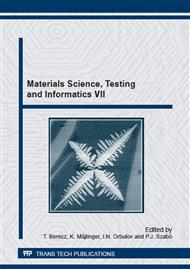p.47
p.53
p.59
p.65
p.71
p.77
p.83
p.89
p.95
The Examination of the Cutting Capacity of Different Aluminium Alloys with Statistical Methods, Using Different Edge Material Non-Conventional (Wiper) Edge Geometry Diamond Tools
Abstract:
The aluminium alloys are used by the automotive, aerospace industries increasingly because of their numerous advantageous mechanical and chemical properties. Surface roughness measurements are essential in characterization of the features of a machined surface. The most widespread aluminium alloy used in cutting is the die-cast type, alloyed with silicon. Industries prefer using two types of such alloys, the so-called eutectic and hypereutectic alloys reinforced with silicon. In this article the cutting capacities of two die-cast aluminium alloys are examined. The cutting experiments were carried out with design of experiment – DOE (the so-called central composite design – CCD). In the course of the examination three factors were altered (cutting speed – vc, m/min; feed – f, mm; depth of cut – a, mm), and the main surface roughness parameters used in the industries were taken as output parameters. The parameters of the manufactured surface roughness and their deviation in case of different workpiece-materials, tool-materials and edge-materials were analysed with statistical methods. Besides minimizing surface roughness, another important criterion of the manufacturing system (machine – tools – chuck – workpiece) is its surface roughness maintaining capacity, which was analyzed with coefficient of variation (CV).
Info:
Periodical:
Pages:
71-76
Citation:
Online since:
February 2015
Authors:
Price:
Сopyright:
© 2015 Trans Tech Publications Ltd. All Rights Reserved
Share:
Citation:


